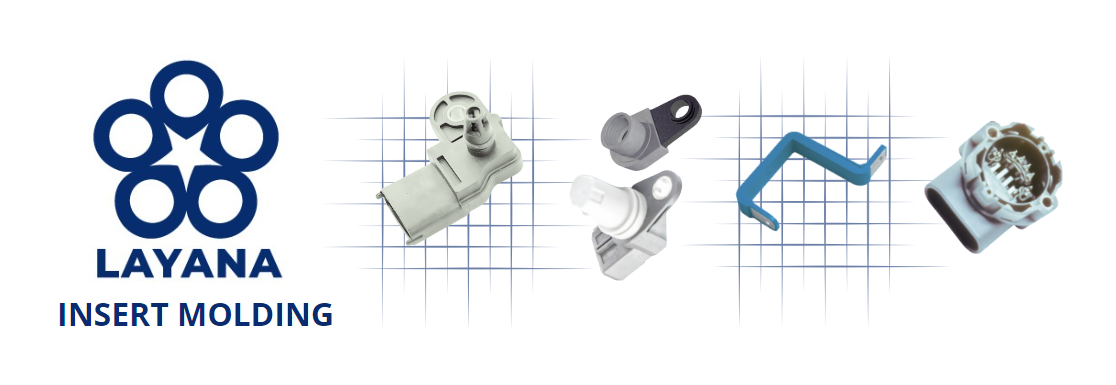
Quick Navigation
What Is Insert Molding?
Insert Molding is a special processing method of plastic injection molding, whereby one or more pre-manufactured inserts can be embedded in the mold during the plastic injection process so that these inserts become part of this finished product. The inserts may be of any material, such as metal, plastic, ceramics, carbon fiber, glass, or rubber. They can be of various geometries, different sizes, and functions: screws, nuts, electric terminals, metal connectors, busbars, plastic sockets, gaskets, etc. The inserts can enhance the mechanical strength, provide electrical connections, offer guidance, or fulfill other functions—ultimately improving the functionality and performance of the final product for any application. For example, metal inserts, such as bushings or threaded inserts, are inserted into the main plastic part to provide strong attachment points for fastening securely in assemblies and disassemblies that will happen frequently in an application, preserving mechanical capability throughout the lifetime of the finished product. On the other hand, plastic inserts may serve as connectors or housings molded directly into the plastic body, both aesthetically and functionally part of the body, engendering fine color, texture, protection, better grip and general appearance between the two parts. This not only offers enhanced durability and precision in the connections but also secures a perfect fitting and alignment of parts.
What Are the Differences Between Insert Molding and Overmolding?
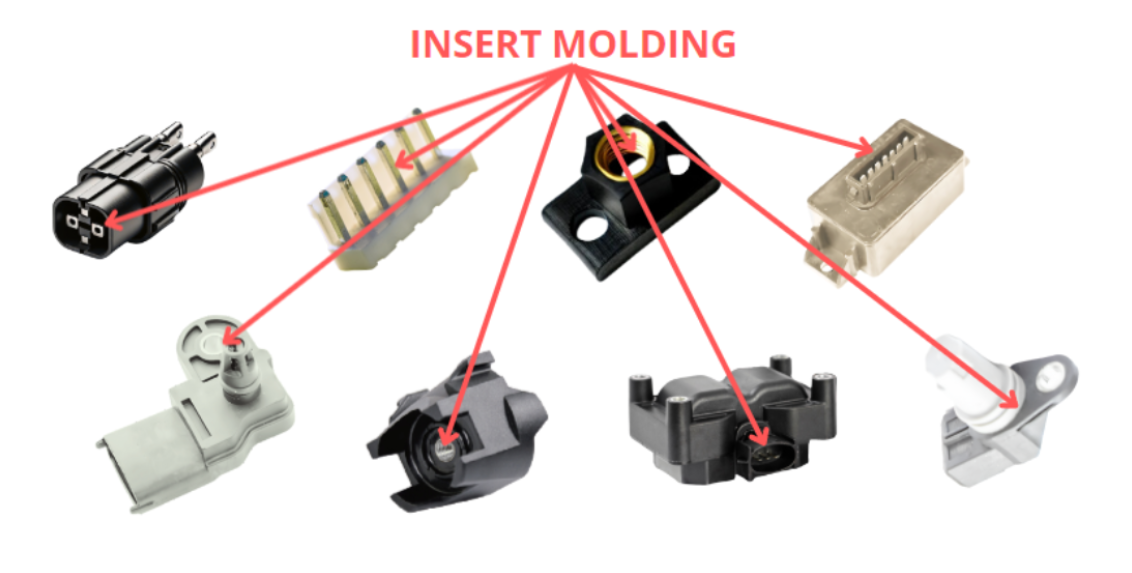 |
Insert MoldingInsert molding and overmolding are two different advanced techniques associated with plastic injection molding technology. On the whole, they share a common technological base, while the cases of application might differ between the two choices. Basically, insert molding is a process whereby pre-fabricated components—generally metal components—are loaded into the mold prior to injection with plastic material in order to add functionality and structural integrity to the finished product. This is generally the most visible plastic part or material integrating with the structural base for the whole finished product. Insert molding technology is very often optimized when plastic injection and metal forming technologies such as metal stamping or machining are integrated. |
OvermoldingOn the other hand, in overmolding, one material is molded over another. Normally, this is plastic over a metal part or plastic/rubber over a plastic structural part. Overmolding could also be understood to be metal or plastic components that are encapsulated or surrounded by plastic. Truly, a number of benefits develop, such as improved grip, enhanced appearance, added protection, and improved mechanical bonding. Overmolding is particularly appropriate for creating bi-material or multi-material parts with different properties like strength, normally contained in metal, and flexibility or softness, normally found in plastic. |
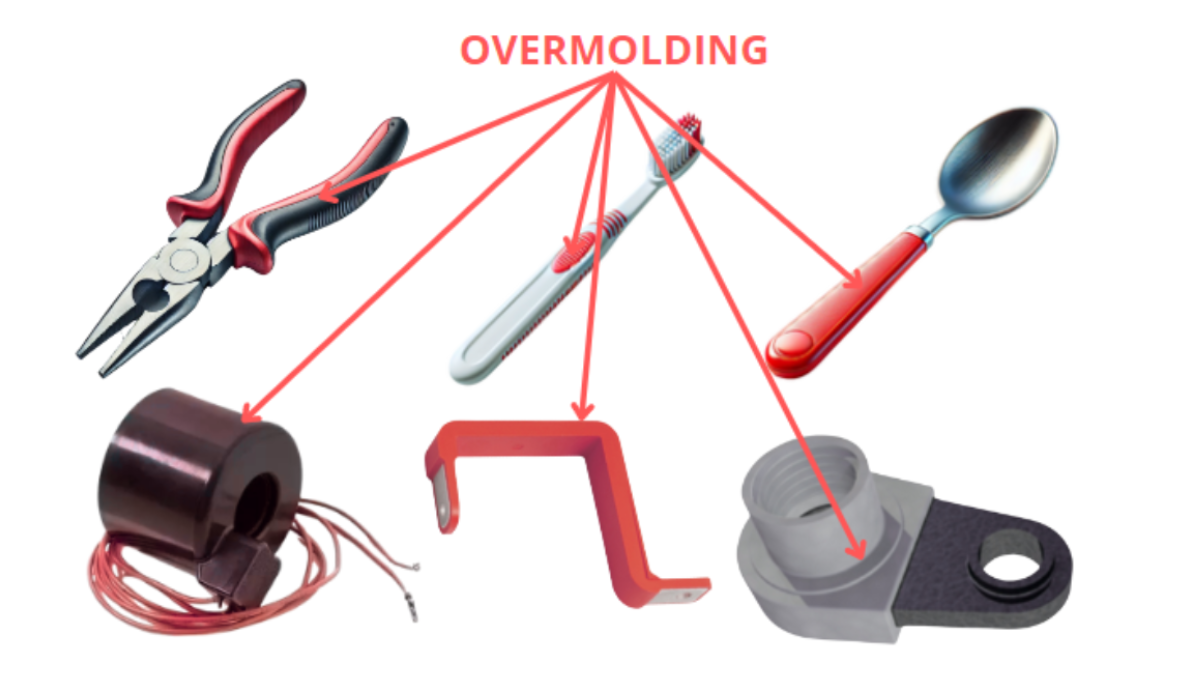 |
Both technologies have great importance in modern manufacturing for the development of complex, high-performance parts designed to meet specific functional requirements. The table below provides a more detailed comparison between the two technologies:
| Types | Insert Molding | Overmolding |
| Definition | Insert molding is an injection process in which one or a number of pre-manufactured metal or non-metal insert(s) are embedded in the mold during the injection process. Thereby the insert is made partly finished product. This will center on the integration of smaller components in the general plastic component. | Overmolding, also an injection molding process, is a process where one or more pre-manufactured metal components or a main structural plastic part is surrounded by plastic material or rubber to enhance structure or to provide other functions such as better grip, increased resistance, better look, etc. with the main focus on enhancing the main metal components. |
| Insert Positioning | Inserts are located precisely in the plastic injection mold to hold their correct position during the actual injection. | The Metal component or the plastic structural part are usually placed in the mold but can be moved when necessary to achieve specific design requirements. |
| Application | Inserts are usually used for applications that require external components to be embedded in plastic parts to provide mechanical strength, electrical connections, or other functions, such as power module housing, connectors or sensors housing, electronic device housing and covers, etc. | Overmolding is usually used for applications that require surrounding metal or plastic parts with a different kind of plastic or rubber to provide protection, increase structural strength, improved grip or better appearance, such as handles, tool handles, protective shells or housing for electronic components, etc. |
| Types of Inserts | Inserts can include metal and non-metal parts, depending on the required function, such as threaded inserts, nuts, fasteners, magnets, sealing, busbars, pins, terminals, or even a first plastic shoot. | Overmolding mainly involves metal components or structural plastic parts, and is usually used to provide additional strength and protection. |
| Example | 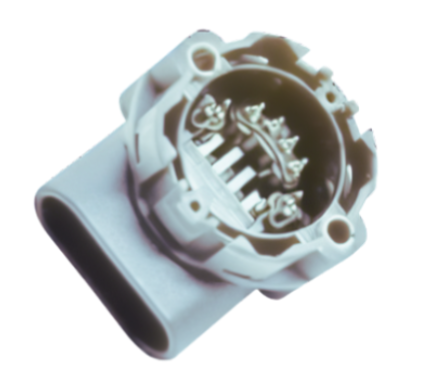 |
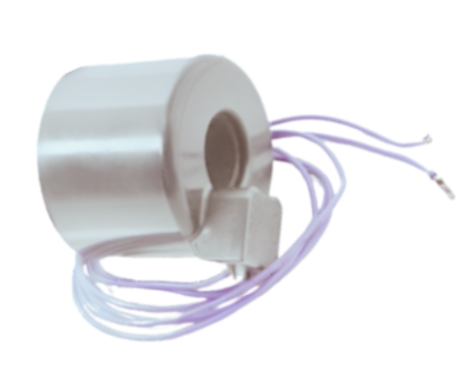 |
The Process of Insert Molding
Insert molding involves the process whereby one or more pre-fabricated inserts or plug-ins are embedded in the mold, along with the plastic injection process, so that these inserts become an integral part of the finished product. The following is a general process about insert molding:
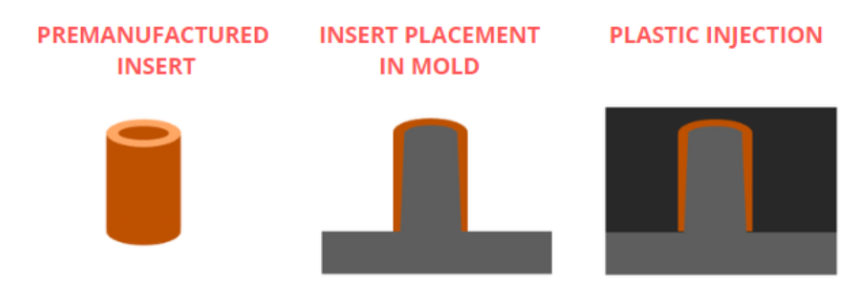
- Insert Preparation: The first step is to prepare pre-manufactured inserts for the process. Inserts are metallic, plastic, ceramics, etc. and, in most cases, they come in definite geometric shapes and perform a special function, which shall be required for the production. Productions efficiency is particularly enhanced when these inserts can be manufactured in the plastic injection molded facility where the insert molding process takes place. This is the case of Layana Company that is able to manufacture a broad spectrum of metal parts, particularly through metal stamping technologies, thanks to its ability to design and develop world-class progressive and transfer dies.
- Mold Design: An appropriate design would be made of the required injection mold to hold the distributed location of the insert inside the mold. The mold could have special slots or holes to locate and introduce the inserts. Insert molding is ore advance technique of plastic injection molding that also requires a more skilled team of mechanical engineers. At Layana, our team of engineers has decades of experience in the insert molding technology, that allowed Layana Company to be one of the key insert molding players in the international manufacturing panorama.
- Injection Machine Setting: The injection is set to heat and inject the required plastic material. The temperature, pressure, and other parameters thereof are set according to the materials used and according to design requirements. Total Quality Management is needed from the design to the mass production stages in order to assure a correct and successful insert molding manufacturing.
- Insert Placement: Put the prepared inserts into the mold. This is a very crucial stage of the process, as the inserts embedding has to be done perfectly into the finished product. The insert has to tolerate the pressure and must be held in a way that it won't move during the injection molding process.
- Injection Molding: Here the plastic material is brought to its molten state and then injected into the mold, with the molten plastic flowing around the inserts and filling up the molded cavity, thereby eventually sealing or encapsulating the inserts in the plastic, creating strong and permanent material bonding.
- Cooling and Solidification: When the plastic has filled the mold and enveloped the inserts, the injection machine will stop injecting and hold for some period to allow the plastics to cool and harden. The cooling time depends on the materials used and the size of the product. Proper cooling is prerequisite for making the plastic harden well and for the inserts to sit firmly within the plastic. This cooling phase is also to prevent any warping or distortion in the finished piece.
- Ejection: After the plastic has completely cooled and solidified, the mold is opened to allow removal of the formed pieces. It requires the gentle removal of the product from the mold, if there is to be no damage or distortion in any way. The ejection stage must be very accurate to ensure that the product will come out with the right shape and intact functionalities.
- Parts Inspection and Post Processing: Quality inspection of these final parts has to be done to possibly undergo post-processing steps, e.g., the trimming of redundant materials. The process is necessary in ensuring that the high-quality standards are met and that the final product is of good quality. Moreover, post-process steps can sometimes even be subjective, such as the painting and coating of the final parts or even assembling work, to meet the exact requirements of the end product.
- Repetition: The entire process can be repeated in order to fabricate various insert molded components. This caters to mass production of products in which quality has been consistent, as well as performance and reliability have been ensured. The repetition of the process ensures that with consistency, each out piece is produced with the same accuracy and quality, making insert molding suitable for large-scale manufacturing.
The Advantages of Insert Molding
Insert molding has several advantages over traditional molding methods and traditional assembly methods. Below you can find some benefits from employing insert molding technology:
- Higher Product Strength: By embedding inserts within the plastic, insert molding can increase the mechanical strength and better material bonding of the final product. This is particularly valid for those products that require additional bracing, durability or environmental resistance.
- Improved Electrical Connections: Insert molding allows for the incorporation of electrical components such as busbars, terminals, pins, or contacts within the plastic itself for a reliable and secure electrical connection. This would be useful for applications such as electronic devices, sensors, control and power modules, chargers, or any other components that require precise and stable electrical connections.
- Reduced Production Costs: Insert molding can reduce production costs by avoiding any extra assembly processes that were needed earlier. With the inserts provided directly at the time of molding, some manufacturing companies will be able to produce products with low labor costs. Layana Company allow the production of complex bi-material products ready-to-use after plastic injection, reducing the cost of post-processing or assembly.
- Design Flexibility: It offers better design flexibility, therefore able to make complex and intricate designs not possible if posterior assembly reeds to be regarded at the design stage.
- Reduction of Longer Assembly: The insert molding reduces assembly time and assembly complexity, since all or a big part of the components are molded into the product during the injection process itself. This comes in handy when manufacturers need to enhance production efficiency and cut down on lead times.
The Disadvantages of Insert Molding
Insert molding has great benefits, although there are some cases where traditional assembly is preferred over insert molding. Below, you can find a list of some insert molding technology drawbacks:
- Increased Tooling/Mold Costs: Insert mold tooling has set up costs in the start and requires greater maintenance compared to the conventional mold process because of its great involvement in the utilization of unique molds and equipment. However, again, higher initial costs are usually counteracted by the higher costs associated with the assembly equipment and fixtures.
- Complexity in Design and Manufacturing: This becomes even more difficult and time-consuming when it comes to designing and manufacturing the mold required for insert molding. This requires the attentiveness of a highly skilled team of mechanical engineers and technicians in order to properly align and integrate the inserts into the molded part. Layana Company engineering team has decades of experience of successful developments in the field of insert molding for worldwide reputed OEM manufacturers.
- Potential Defects: In case of mismanagement, insert molding may result in defects such as miss-alignments of the inserts, incomplete molding, or material flow problems. This can affect the overall quality and performance of the final product. For this reason, it is imperative to choose a trustable insert molding partner able to offer in house tooling design and development capabilities and full TQM through the whole manufacturing process.
- Material compatibility: This is a very critical factor that should be done with experience and competence concerning insert molding technology. Various materials will have different thermal as well as mechanical properties that have to be very well considered so that no problem during the molding process is experienced. The thermal properties, inclusive of the melting point, thermal conductivity, and heat deflection temperature of the material, will determine the nature of the material during molding under heat. Layana Company mechanical engineering team can assist your team to choose the proper materials or solve design issues from a very early design stage. Due to the very high temperature of molten plastic, the limited options available in insert material mean that not all materials can be an option for manufacturing the insert in the process of molding. It might somehow limit the options of materials for some applications.
The Applications of Insert Molding
Insert molding is used in a wide range of industries. Some common industries where insert molding is widely employed are:
- Automotive Industry: Insert molding is used to produce various automotive components, such as connectors, switches, and sensors, found by hundreds in every car. These components require precise and reliable electrical connections, making insert molding a preferred choice. Recently, insert molding technology has been widely employed in the development of EV parts such as power charging systems, power electronics or control units. Layana Company, whose strength in insert molding has been proved for decades, is certified as an IATF16949, and produces insert molding parts for all class of OEM clients in the automotive industry.
- Electronics Industry: Insert molding is widely used in the electronics industry to produce components such as connectors, sockets, and housings or covers, but also more comprehensive electronics devices such as automatic door handle locks, networking equipment such as modems or server rack connections, or even wearables. In the IoT industry, the possibilities that insert molding provides are almost infinite.
- Medical Industry: Insert molding is used to produce medical devices and components, such as surgical instruments, implants, and diagnostic equipment. The ability to embed metal, plastic, ceramics and other materials within the plastic structural component provides the required strength and functionality for medical applications.
- Consumer Goods: Insert molding is used to produce various consumer goods, such as handles, knobs, and fasteners. The ability to integrate inserts within the plastic provides additional strength and durability for these products. Layana Company, apart from the OEM business unit, also has its own premium cutlery brand where had the chance of implementing the most innovative methods of insert molding to create products that outreach the international competitors, such as the BaoQuai chopsticks.
- Aerospace Industry: Insert molding is used to produce components for the aerospace industry, such as connectors, housings, and brackets. The ability to embed metal and other materials within the plastic provides the necessary strength and reliability required by the high standards of this industry.
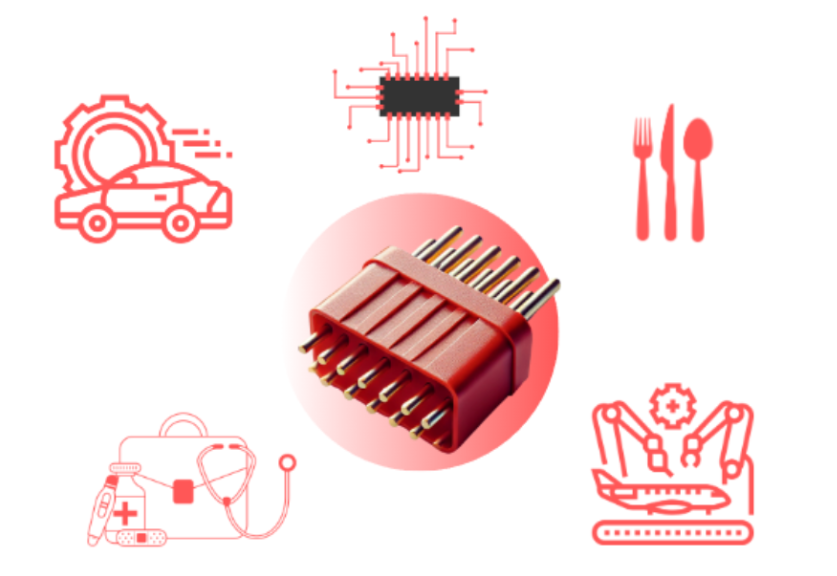
The Materials of Insert Molding
Whether we regard plastic, metal or other materials, insert molding technology can utilize a broad catalog of materials to achieve the desired properties and performance for the insert molded product application. The choice of materials will depend on the specific of the parts, as well as the environment where it is going to be used, apart from the intended function of the inserts and the mechanical properties of the insert material. Some common resins used in insert molding include PPS, PPA, PBT, PET, PC, POM, Delrin, ABS, PA66 TPU, Nylon, Acrylic, etc.
|
Material |
Tensile Strength (MPa) |
Flexural Strength (MPa) |
Impact Resistance (kJ/m²) |
Hardness (Shore D) |
Melting Point (°C) |
|---|---|---|---|---|---|
|
PP |
25 |
20 |
10 |
70 |
160 |
|
PA66 |
75 |
40 |
8 |
85 |
260 |
|
ABS |
50 |
30 |
12 |
80 |
220 |
|
PC |
90 |
60 |
18 |
90 |
300 |
|
POM |
85 |
50 |
15 |
88 |
230 |
|
PPS |
70 |
55 |
9 |
92 |
280 |
|
PPA |
65 |
45 |
7 |
86 |
290 |
|
PBT |
55 |
35 |
10 |
78 |
220 |
|
PET |
60 |
40 |
8 |
82 |
250 |
|
TPU |
45 |
25 |
20 |
85 |
180 |
|
Nylon |
70 |
45 |
10 |
84 |
255 |
|
Delrin |
75 |
50 |
12 |
88 |
180 |
|
Acrylic |
55 |
30 |
5 |
95 |
160 |
- Polyphenylene Sulfide (PPS) stands out for its excellent tensile strength and chemical resistance, making it ideal for high-temperature and chemically aggressive environments. PPS is broadly employed in automotive parts, electrical components, and industrial machinery. It has a melting point of around 280°C.
- Polyphthalamide (PPA) offers excellent thermal resistance and high strength, suitable for applications requiring thermal stability, such as automotive engine components and electrical connectors. Its primary drawbacks are high moisture absorption, which affects dimensional stability, and moderate flexibility. PPA is predominantly used in the automotive and electronics industries. Its melting point is quite high, about 300°C.
- Polybutylene Terephthalate (PBT) is well known for its excellent dimensional stability and high electrical insulation, making it ideal for precision parts needing good electrical insulation. However, its toughness and chemical resistance are moderate. PBT finds applications in connectors and housings for electrical components, mainly within the electronics and automotive industries. The PBT's melting point is approximately 225°C.
- Polyethylene Terephthalate (PET) boasts high tensile strength and good wear resistance, suitable for mechanical strength applications. Despite its moderate heat and impact resistance, PET is widely used in mechanical parts and food and drinks packaging, serving industries like consumer goods and automotive. Its melting point is around 255°C.
- Polycarbonate (PC) excels in impact strength and transparency, making it perfect for impact-resistant and transparent applications like safety glasses and electronic housings. Its chemical resistance and scratch resistance are moderate, limiting some uses. PC is used extensively in the medical, electronics, and automotive industries. Its melting point is approximately 230°C.
- Polyoxymethylene (POM, Delrin) is renowned for its excellent wear resistance and low friction, making it ideal for high-precision mechanical parts like gears, bearings, and fasteners. POM is used in the automotive and consumer goods industries. Its melting point is quite low, around 175°C.
- ABS (Acrylonitrile Butadiene Styrene) combines good mechanical properties such as toughness, impact resistance, and heat resistance, making it suitable for a wide range of applications including automotive parts, electronic housings, and consumer products. ABS offers a balanced performance and is easy to process. The melting point of ABS is approximately 105°C.
- PA66 (Nylon 66) offers high tensile strength and excellent wear resistance, making it suitable for high-strength, wear-resistant applications like gears, bushings, and automotive parts. Its high moisture absorption and moderate impact strength are its main drawbacks. PA66 is used extensively in the automotive and industrial sectors. The Nylon 66's melting point is around 255°C.
- Thermoplastic Polyurethane (TPU) is highly flexible and abrasion-resistant, suitable for flexible and durable applications such as hoses and cable jacketing. TPU is commonly used in consumer goods and automotive industries. TPU's melting point is 180°C approximately.
- Nylon (Polyamide) offers high tensile strength and good wear resistance, making it suitable for high-strength, wear-resistant applications like gears, bushings, and automotive parts. Its high moisture absorption and moderate impact strength are its main drawbacks. Nylon is used extensively in the automotive and industrial sectors. The Nylon’s melting point is around 220°C.
- Acrylic (Polymethyl Methacrylate, PMMA) is known for its excellent transparency and good weather resistance, perfect for transparent applications such as display screens and light fixtures. Its impact and scratch resistance are quite poor, and it has a low melting point, 160°C.
- Special Material: Peek. Peek is a high-performance, thermoplastic material that shows very impressive mechanical and chemical resistance properties and therefore will find applications in very demanding industries such as aerospace, automotive, and medical. While it does offer very exceptional performance, it is not without its drawbacks—the very high cost and processing problems. For high-performance applications, inserts manufactured from metals like titanium and stainless steel can be used, as the melting point of PEEK is of the order of 343°C.
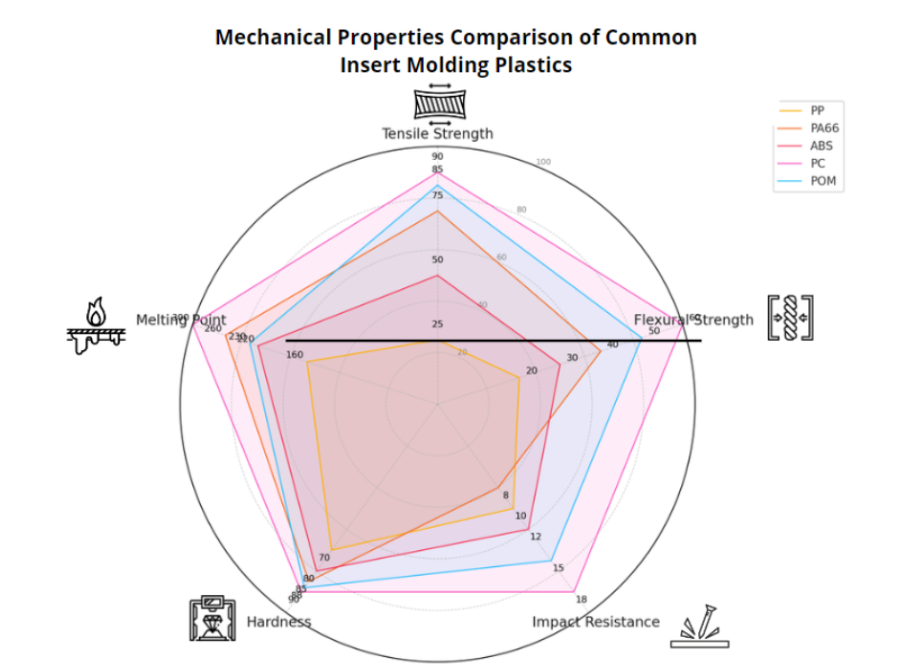
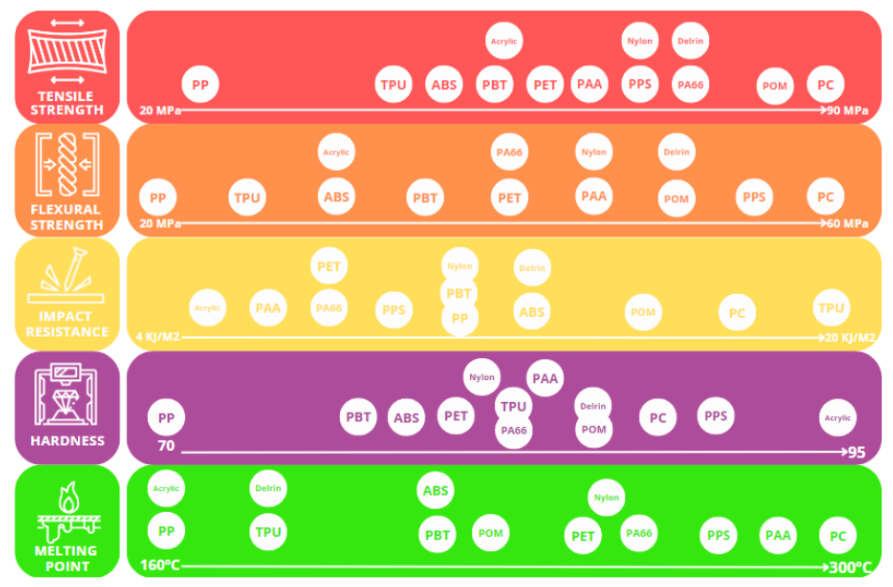
The Types of Inserts in Different Industries
Apart from resins, other key part of the insert molding is the material, geometry and application of the inserts. These can vary from different industries. Below are a list of common types of inserts found in insert molding applications through different industries:
Automotive Industry:
Metal Inserts:
- Threaded Inserts: Used for creating strong and durable threaded holes allowing repetitive assembly and disassembly of the finished part.
- Bushings and Bearings: Used for components that require rotation or movement.
- Connectors, terminals and busbars: For electrical connections within automotive assemblies. Sensors are some of the most common applications where insert molding is employed. Insert molding allows the correct isolation and parallelism of the terminals.
- Pins and Rivets: For securing components and providing pivot points.
Plastic Inserts:
- Grommets and Seals: For vibration damping and sealing applications. Insert molding allows better and more durable insolation than traditional assemblies.
- Insulators: For electrical insulation purposes.
Electronics Components:
- Sensors: Insert molding allows environmental protection and correct integration of different kinds of sensors.
- Circuit Boards: Incorporated into housings to protect delicate electronics and very limited given design concerns and plastic melting point.
Electronics Industry:
Metal Inserts:
- Threaded Inserts: For securing components to enclosures or other parts.
- Shielding Components: To protect against electromagnetic interference (EMI).
- Heat Sinks: For thermal management of electronic components.
Plastic Inserts:
- Spacers and Supports: For maintaining component alignment and spacing, or improving structural support.
- Connectors: For integrating various electronic modules.
Electronic Components:
- Resistors, Capacitors, and Inductors: Embedded within plastic parts for protection, space and assembly time saving.
- Microchips and Integrated Circuits (ICs): For complex electronic functionalities.
Consumer Industry:
Metal Inserts:
- Metal cutlery tips and blades: As seen in the BaoQuai chopsticks case, insert molding can be used to integrate metal and plastic parts for cutlery manufacturing, achieving premium quality designs that are more durable, resistant and have better appearance.
- Threaded Inserts: Used in consumer products like home appliances for repetitive assembly and disassembly.
- Pins and Bushings: For parts that require movement or alignment.
- Clamps and Fasteners: For securing components in place.
- Decorative Elements: Embedded for aesthetic purposes.
Plastic Inserts:
- Hooks and Clips: For assembling or hanging components.
- Decorative Elements: Embedded for aesthetic purposes.
Functional Components:
- Batteries: Encased within plastic for safety, durability and better handling.
- Sensors and Actuators: Embedded for smart functionalities in IoT devices.
Medical Industry:
Metal Inserts:
- Surgical Grade Stainless Steel Inserts: For biocompatibility and corrosion resistance.
- Implantable Components: For devices such as pacemakers and orthopedic implants.
- Threaded and Press-Fit Inserts: For assembling medical devices with precision.
Plastic Inserts:
- Seals and Gaskets: For maintaining sterility and preventing leaks of any type.
- Catheter Components: For flexibility, easy integration and correct bonding with other medical devices.
Medical Electronics:
- Sensors: For monitoring patient vitals and integrating with electronic systems.
- Microfluidic Channels: Embedded within plastic for lab-on-a-chip applications.
Aerospace Industry:
Metal Inserts:
- High-Strength Threaded Inserts: For withstanding extreme forces, humidity and temperatures.
- Bushings and Bearings: For critical moving parts and structural components that need to resist great forces.
- Fasteners and Rivets: For securing aircraft components, structural parts and panels.
Plastic Inserts:
- Insulators: For electrical insulation.
- Lightweight Spacers: For reducing overall weight while maintaining structural integrity, common requirements in the aerospace industry.
Aerospace Electronics:
- Sensors: For monitoring aircraft systems and environmental conditions.
- Connector Housings: For protecting sensitive electronic connections from harsh conditions such as low temperatures, high humidity or extreme pressure.
Layana's Capabilities of Insert Molding
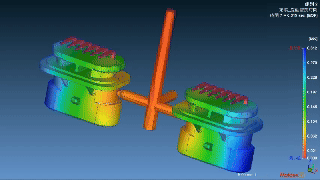 |
| Item/Type | Vertical Injection Machinery | Horizontal Injection Machinery |
|---|---|---|
| Tonnage Range | From 35T to 250T | From 60T to 200T |
|
Maximum Product Size |
INCH: 8.5 x 11 x 6 MILLMETER: 216 x 279 x 150 |
|
|
Maximum Product Weight |
0.1g~500g | |
| Preciseness |
Mold: ± 0.005mm Product: ± 0.03~0.05mm |
|
One of Layana’s highest strength is proficiency in insert molding technologies given its board experience with plastic injection and progressive and transfer die metal stamping technologies, Total Quality Management capabilities and scientific method. Layana counts with an extensive portfolio of plastic injection machine, metal stamping presses, in house tooling fabrication capabilities, CNC machine, TQM equipment, and a robust network of row material suppliers that allow Layana to be a valued partner of Global OEMs for their insert molded products. Layana Company not only counts with a talented team of mechanical engineers with decades of experience manufacturing insert molded products, also counts with IATF16949, ISO 50001 and ISO 14064 certifications, apart from Green building, Cleaner Production System and Green Factory certification. Layana's capabilities in insert molding extend beyond just the production of high-quality parts. The company offers a comprehensive range of services, including:
- Precision Injection Molds: Layana designs and manufactures precision injection molds that ensure the accurate positioning and embedding of inserts within the plastic parts. These molds are designed to meet the specific requirements of each application, ensuring optimal performance and reliability. Layana’s team of experts will always accompany your team to early identify potential design or manufacturability issues.
- Progressive and Transfer Stamping Dies: Layana Company’s progressive stamping dies enable the efficient production of a huge range of metal inserts, which can be efficiently integrated into the plastic parts during the insert molding process.
- Mold Maintenance: Layana's mold processing services ensure that the molds are well maintained and optimized for consistent performance. This includes regular inspections, maintenance, and adjustments to ensure that the molds continue to produce high-quality parts.
- Injection Molding: Layana's injection molding services utilize advanced machinery and techniques, always supervised by a talented team of plastic injection expert engineers to produce high-quality plastic parts with embedded inserts.
- Metal stamping Manufacturing: Layana's metal stamping capabilities include the mass production and finishing of metal inserts, which can be integrated into the plastic parts during the insert molding process in a cost-effective and time efficient manner. This capability allows for the efficient production of high complexity, multi-material parts.
- Product Assembly: Layana company offers product assembly services after plastic injection to ensure that the final products are fully assembled and ready for use, in case there are still parts that are not integrated in the finished product through insert molding.
Layana's comprehensive range of services and expertise in insert molding make it a valuable partner for manufacturers looking to produce high-precision, durable products with complex geometries and features. At Layana, we are always committed with the quality and customer satisfaction is always a must in our commitment to always reach the highest standards of performance and reliability.
In conclusion, insert molding is a versatile and efficient manufacturing process that offers numerous advantages for producing complex and durable products, reducing or eliminating the need for posterior assembly, or simplifying the assembly. By embedding inserts within the main plastic part, this technology can enhance product strength, better material bonding, improve electrical connections, increase the aesthetics of the parts, increase the environmental resistance, etc. reducing production costs, assembly complexity and production lead time. Layana company's expertise and comprehensive range of services in insert molding make it an ideal partner for manufacturers looking to produce high-precision and durable and insert molded products or parts, all while resting assured that highest environmental protection standards are always met.




